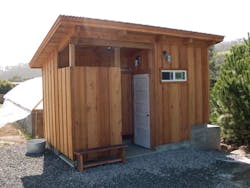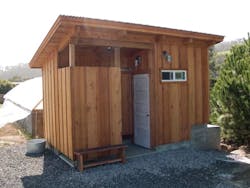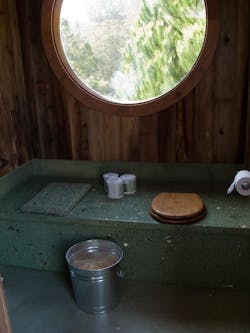A friend sent me this link to an article about a $2.2 million grant awarded to a Univerasity of Toronto engineering team by the Bill & Melinda Gates Foundation: http://www.homelandsecuritynewswire.com/dr20121129-engineers-awarded-2-2-million-grant-for-research-on-new-toilet-design.(Read the article before you continue reading this column.) After reading this, it seemed to me that a letter to Bill and Melinda might be in order, so here it goes!
Dear Bill & Melinda,
Please cancel the $2.2 million grant for a waterless toilet, and contact your local plumber who will, no doubt, be willing to settle for half ($1.1 million) to let you in on what’s not much of a secret — waterless toilets already exist. In fact, they’ve existed from the dawn of human existance in many forms!
Outhouses: While the outhouse, or privy, may not have been the most sanitary form of waterless toilets, it has served well in archeological digs to reveal artifacts casually, or deliberately, discarded while also serving the occupants’ needs. Open trenches or cesspool pits gave way to outhouses following advances in medicine that revealed the underlying cause for those deaths: drinking their own sewage-contaminated water.
In neighboring Lancaster, Pa., an Amish man, Andy Swartzentruver, was fined $1,000 for recycling the waste from a school outhouse because he refused to comply with the township’s sewage regulations. He was also sent to prison for 90 days.
Where I grew up, our neighbor lived a quarter mile away on a dirt road. They had two privys: one outdoor for use during summer months, and the other indoors with a metal bucket as the receiver. Whoever was responsible for filling the bucket to the full mark was also the person responsible for carrying the bucket off to be dumped in the outdoor privy. We kids learned to cross our legs if the bucket was nearly full!
Many of our customers convertedtheir backyard privys when their homes received indoor plumbing. Being practical, but also frugal Pennsylvania Dutch, they installed antifreeze toilets in the backyard privy while adding plumbing for sinks inside their homes. Why let a perfectly good outbuilding go to waste when it could continue its use for handling waste? Or maybe that was because bathroom exhaust fans were not yet invented.
Destrolet: While employeed as a journeyman plumber in 1976, I was dispatched to repair a bath sink faucet at a service station.
When going to this job, I was told, “While you’re there, the toilet is leaking and you need to figure out the problem and get it fixed.”
Repairing the sink faucet was easy, but the toilet was another matter. Looking and working much like the antifreeze toilets of old, only stainless steel instead of cast iron, a hinged seat activated the flushing mechanism: an oil-fired burner at the bottom of the pit designed to incinerate human waste! My boss laughed till he had tears streaming down his cheeks.
In addition to the destrolet there is an Incinilet, www.incinolet.com,brand of toilet that uses electricity (no water) to turn pee and poop into harmless germ-free ash. Think PV-solar Mr. Gates and the possibilities for those third-world areas where water is contaminated by human waste. Just 1.5-kWh per use is required. Excess PV power could be used to pump clean water from the earth (diamatocious filtration) and treated with UV sterilization (if required) while indoor lighting would reduce pollution from oil lamps or wood fires used to illuminate the homes. Enhanced health all around!
Cathole: In Boy Scouts, the Leave No Trace doctrine teaches you how to to properly dispose of human waste without using water. Using a small garden trowel, dig a hole six inches in diameter by eight inches deep (if in the desert or arid lands, make it four inches deep to allow solar heat to aid in the process). Cover after use to allow the decaying process to begin and stay at least 200 feet away from surface drinking water resources.
Composting loo: Loo is a British term for toilet. The ultimate in waterless toilets, a composting loo can be a viable solution to pollution. Not to be confused with “Skip to the Lou My Darling,” which is a song in which Lou was taken from the Scottish word for love — Loo.” Obviously the Scots and the Brits would have had a dire need for an interpreter!
A wooden loo at an organic farm.
Composting toilets, however, do require more human interaction beyond deposting wastes and therein lies the rub. It is necessary to add composting materials after every few uses and the user does need to either rotate the drum via a recessed handle or turn the “bed” by hand while ensuring sufficient moisture is present to promote composting. The composting process is also temperature sensitive and ceases to function in cold weather unless warmed by a heating element (available in some models).
For example, Jay and Suzie, acquaintances of mine, operate an organic farm and host dinners where all-natural and local ingredients are featured. They have a lavish two-seater composting loo that they maintain. “Best darned crapper on the West Coast,” exclaimed Suzie!
Inside the wooden loo.
Also, several local customers have been using composting toilets for decades and swear by them, not at them. I became the caretaker for a composting toilet two years ago, so I too have first-hand experience and the maintenance isn’t a problem.
Methane digester: Multiple resources for plans that incorporate the use of human waste (and other organic wastes) are available for free on the Internet. While I realize this moves away from waterless to utilizing water for the digester’s process, the by-product gases can be utilized for cooking, heating and gas lights. Human waste can be utilized because any harmful bacteria are killed in the burning of the methane. Energy-content averages 650-Btu per cubic foot (65% methane). Waste not — want not!
Disease and pestulence brought about by improper disposal of human waste was, at one time, the single largest cause of death for humans and caused many of the worst world-wide pandemics. In major port cities in the U.S., during the late 1800s and early 1900s, it was not uncommon for thousands to die each year from typhoid, cholera and dysentery. And sadly, drinking contaminated water continues to be a killer in undeveloped countries, and human waste is often the root cause of the contamination.
All Dave Yates material in print and on Contractor's Website is protected by Copyright 2013. Any reuse of this material (print or electronic) must first have the expressed written permission of Dave Yates and Contractor magazine. Please contact via email at: [email protected].
About the Author
Dave Yates
Dave Yates material in print and on Contractor’s Website is protected by Copyright 2017. Any reuse of this material (print or electronic) must first have the expressed written permission of Dave Yates and Contractor magazine.


